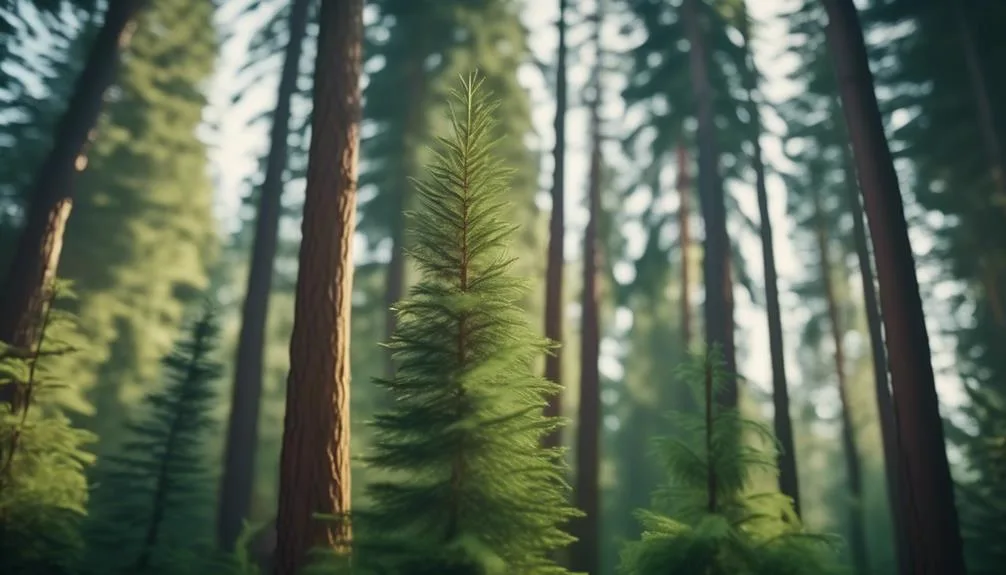Looking to spruce up your landscape with fast-growing spruce trees? You're in for a treat!
Whether it's the stunning Colorado Spruce or the versatile Sitka Spruce, there are great options to explore. These trees not only add beauty and shade but also bring various benefits to your outdoor space.
Each variety has unique characteristics and growing conditions worth discovering. Whether you're a seasoned gardener or just starting out, fast-growing spruce trees can transform your garden.
Benefits of Fast-Growing Spruce Trees
If you're looking for a quick and effective way to add shade, privacy, and beauty to your landscape, fast-growing spruce trees are an excellent choice. These trees not only enhance your landscape design, but they also provide environmental benefits.
Fast-growing spruce trees help in purifying the air by absorbing pollutants and releasing oxygen. They also offer economic advantages by reducing energy costs through their wind-blocking properties. Additionally, when strategically planted, these trees can increase property value by adding to the aesthetic appeal of your home.
Their rapid growth means you won't have to wait long to enjoy these benefits. Whether it's for their environmental impact, economic advantages, or enhancing your property's value, fast-growing spruce trees are a valuable addition to any landscape.
Characteristics of Colorado Spruce
When considering fast-growing spruce trees, the Colorado Spruce stands out for its distinct characteristics that make it a desirable addition to any landscape. The Colorado Spruce, also known as the blue spruce, is prized for its striking blue-green needles and pyramid-like shape. Its slow to medium growth rate and tolerance for various soil types make it an excellent choice for landscaping. Here are some key characteristics of the Colorado Spruce:
| Characteristics | Description |
|---|---|
| Needle Color | Blue-green |
| Growth Rate | Slow to medium |
| Shape | Pyramid-like |
Incorporating Colorado Spruce into your landscape can create a visually appealing focal point. Consider using it as a standalone specimen, a windbreak, or as part of a mixed evergreen planting for a beautiful and diverse landscape.
Growing Sitka Spruce in Various Climates
Sitka Spruce trees thrive in a variety of climates, making them a versatile and resilient choice for landscape planting. These trees are adaptable to changing climates, making them a great option for areas experiencing environmental shifts.
When it comes to urban areas, Sitka Spruce can be successfully cultivated, adding a touch of natural beauty to city landscapes. Whether you live in a bustling city or a suburban neighborhood, Sitka Spruce trees can thrive and provide numerous benefits, such as improving air quality and offering a habitat for wildlife.
With proper care and attention, these trees can withstand the challenges of urban environments and contribute to a greener, healthier urban landscape. Their ability to adapt to changing climates also makes them a valuable asset in the face of climate change.
Planting and Caring for Norway Spruce
Planting and caring for Norway Spruce involves:
- Selecting a suitable location with well-drained soil and ample sunlight to ensure healthy growth and development of the tree.
- Norway spruce maintenance is relatively low, but it requires regular watering, especially during the first few years after planting.
- The soil requirements for Norway spruce include acidic, well-drained soil with a pH level between 4.5 and 6.5.
- Before planting, it's essential to prepare the soil by loosening it to a depth of at least 12 inches and incorporating organic matter.
- When planting, ensure the root collar is level with the ground and mulch around the base to retain moisture.
- Regularly monitor for pests and diseases, and prune as necessary to maintain a strong central leader and remove dead or damaged branches.
- With proper care, Norway spruce can thrive and enhance the beauty of your landscape.
Utilizing Hybrid Spruce Varieties
Selecting hybrid spruce varieties can be an exciting way to expand your landscaping options, especially if you've already mastered the care of Norway spruce. When considering hybrid tree breeding, it's important to note that these varieties often exhibit faster growth rates and increased resistance to common pests and diseases.
Here are a few reasons why utilizing hybrid spruce varieties is beneficial:
- Enhanced Traits: Hybrid spruce varieties are bred for specific desirable characteristics, such as faster growth rates and improved adaptability to various soil types and climates.
- *Diverse Aesthetics*: Hybrid spruce varieties offer a wide range of unique colors, shapes, and sizes, allowing for diverse landscaping opportunities.
Conclusion
Incorporating a fast-growing spruce tree variety into your landscape offers the benefits of rapid growth, stunning characteristics, and adaptability to various climates.
Whether it's the Colorado Spruce, Sitka Spruce, Norway Spruce, or a hybrid variety, with proper care, these trees can thrive and enhance your outdoor space for years to come.
Consider the potential of these spruce varieties to elevate your surroundings and provide lasting beauty.

My interest in trees started when I first saw the giant sequoias in Yosemite.
I was a teenager then, and I remember thinking, “I need to learn more about this.”
That moment stuck with me.
A few years later, I went on to study forestry at Michigan Tech.
Since graduating, I’ve worked in a mix of hands-on tree care and community education.
I’ve spent over ten years helping people understand how to plant, maintain, and protect the trees in their neighborhoods.
I don’t see trees as just part of the landscape.
They are living things that make a real difference in our daily lives.
